The South Australian Pottery
Located near the corner of Norton Summit and Magill Roads, Magill, adjoining Third Creek, in an area that was once part of the Village of Woodforde. (The Express and Telegraph, 1869, p. 4) The South Australian Pottery was established in 1865 by the Welsh potter, Robert Davies. (Ioannou, 1986, p. 77) He arrived in South Australia, together with his wife Henrietta (nee Henshall), in April 1864 on board the ship ‘Ocean Chief’, aged 21 years. (South Australian Register, 1864, p. 3)
In a lengthy letter to the editor written in 1903, Robert Davies gives an account of his reasons for emigrating and of his first few days in the colony.
“It is out of love for this beautiful Adelaide, for the welfare of my beloved adopted country, that I speak. My experience in foggy England, seeing my brothers and sisters fall victims to that fell disease, consumption [i.e. tuberculosis], was not a happy one; and on being told by my medical advisers that the only thing to save my life would be to take a long voyage to some sunny clime, I determined to come to Adelaide, this beautiful land of blue skies and life-giving sunshine, to which I am indebted for many blessings, and though, now many years have passed I still retain the happy experience of being the possessor of perfect health. Well can I remember, the second day after my arrival in this State, when trudging up the Third Creek, and coming to the late Mr. Giles' orchard [near Magill], hearing the sound of laughter. On asking a passer-by what was the cause of so much happiness I was informed that it was a laughing jackass [i.e. kookaburra]. The man certainly must have taken me for a lunatic when he witnessed my gyrations, for I jumped for joy, and said, ‘The Lord be praised for this happy land, where even the donkeys are filled with laughter.’” (The Advertiser, 1903, p. 9)
It is interesting to note that Davies went almost immediately to the future site of The South Australian Pottery on the banks of Third Creek at Magill, suggesting that he may have purchased the property prior to his departure from Wales.
Although he speaks of ‘foggy England’, Davies was in fact Welsh, and apprenticed with The South Wales Pottery in Llanelly. (Kapunda Herald, 1903, p. 3) In December 1865, Robert Davies wrote to the Commissioner of Public Works “making application at the Immigration Office for men to be sent out of the trade of potters”. Davies goes on to specifically request “that all persons coming through Mr. W. T. Holland, South Wales Pottery, Llanelly, might be allowed a free passage to Adelaide”. (South Australian Register, 1866, p. 2)
However, The South Australian Pottery was not successful, probably owing to excessive competition from cheap imports made in Great Britain and the neighbouring Colony of Victoria, which limited the market for locally made pottery. (Ioannou, 1986, p. 14) By 1866, Robert Davies was forced to mortgage his property and take William Piercy into partnership. (Ioannou, 1986, p. 77)
William Piercy, together with his first wife Sarah (nee Chandler) and four children, arrived in South Australia in March 1866 on the ship 'Trevelyan'. (Ford, 1985, p. 27) Piercy, who was born at Nettlebed in Oxfordshire, England, came from a family with a 200-year-old tradition as potters and received two year's training at Doulton Limited, of Lambeth, London. (The West Australian, 1931, p. 5)
In 1868, 'The Express and Telegraph' newspaper published an extensive account of potteries and brickfields then operating in South Australia, including The South Australian Pottery, run by Messrs. Davies and Piercy. The pottery was described as consisting of "a puddling hole, a drying pan, a pug mill, a kiln 9 feet high by 6 feet in diameter, and various other appliances of a pottery." The article went on to say that "a larger kiln is also about to be erected to keep pace with increased demand which is springing up." As to the division of labour, the article stated that "Mr. Pierce <sic.> does the 'throwing' work, and Mr. Davies 'moulds'. Besides these gentlemen, a man and boy are employed in preparing the clay." (The Express and Telegraph, 1868, p. 2)
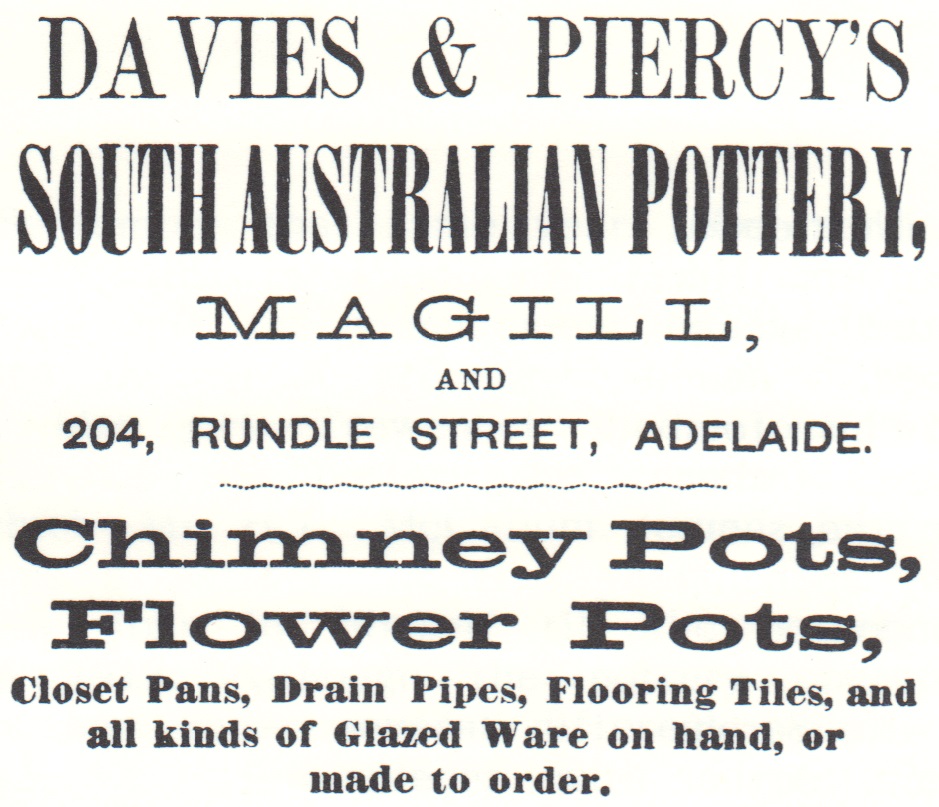
(Boothby, 1869, p. Adv. 112)
In December of the same year, 1868, Davies and Piercy had their first commission of note, an ornamental terracotta fountain for Mrs. Fox of ‘Marybank’ Estate, Rostrevor, which the article claimed to be "we believe, the first fountain of this kind which has been manufactured in the colony." (South Australian Chronicle and Weekly Mail, 1868, p. 11) The fate of the fountain is unknown, but given the brittleness of terracotta, it is unlikely to have survived.
Despite the best efforts of Davies and Piercy, the pottery became insolvent in November 1869 (South Australian Register, 1870, p. 2), resulting in the dissolution of their partnership and the sale of the pottery itself. (Evening Journal, 1869, p. 4) Davies later blamed the quality of the local clay for the demise of the pottery (Chronicle, 1903, p. 35), but it might have been that he simply over capitalised in such a limited market. There were only 185,425 European colonists in South Australia at the time of the 1871 Census. (South Australian History Timeline)
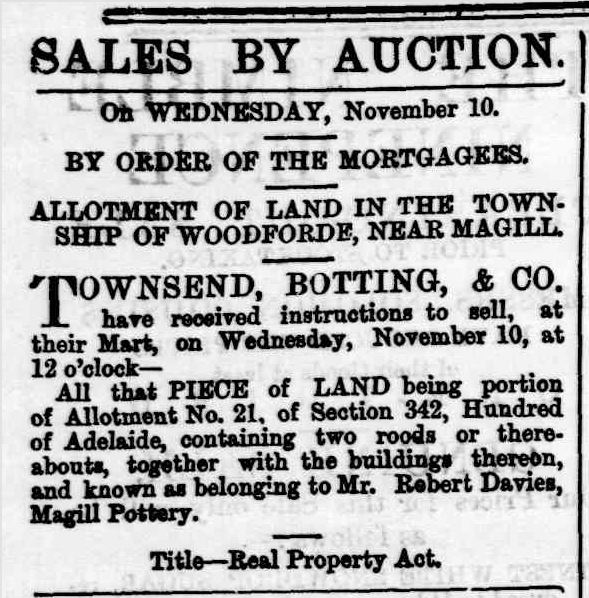
(The Express and Telegraph, 1869, p. 4)
Davies then relocated to Melbourne and started a gas retort, firebrick, and tile works at South Yarra, which he operated until 1889. (Chronicle, 1903, p. 35) Only to return to South Australia in 1902 to help establish The Longwood Tile and Pottery Company at Longwood Gully near Aldgate. (Ioannou, 1986, p. 131) This turned out to be another ill-fated venture that ended with voluntary liquidation in 1906. (Evening Journal, 1906, p. 1) Although Robert Davies remained in the Longwood Gully area for sometime afterwards, he died at Solomontown, Port Pirie, in 1916. (Port Pirie Recorder and North Western Mail, 1916, p. 2)
In the meantime, The South Australian Pottery, Magill, was purchased by Charles Giles, a horticulturalist, who owned ‘Grove Hill’ Estate, Norton Summit, about three kilometres upstream along Third Creek, who was a business acquaintance of Robert Davies and William Piercy. (Ioannou, 1986, p. 78) William Piercy then leased back the defunct pottery and continued trading as The South Australian Pottery. (Ioannou, 1986, p. 77)
At first, William Piercy carried on the pottery in a small way, with just the assistance of two of his sons, William Piercy, junior, aged 11, and Arthur Piercy, aged 9. This is the only known period when their wares included a potter's mark, 'W. Piercy, S.A. Pottery, Magill'. (Ford, 1985, p. 28)
By 1873, William Piercy had commenced a new partnership with J. T. Tyley, a monumental mason and sculptor from Kapunda, and branched into architectural terracotta, such as sill trusses, cantilever supports, ornamental scrolls, and keystones decorated with human heads. (The Express and Telegraph, 1885, p. 4) However, a lawsuit with J. M. Donaldson, a Church of England clergyman at Kapunda, over the price of a Church font (Evening Journal, 1877, p. 2), seems to have resulted in the end of their partnership in 1877. (Express and Telegraph, 1877, p. 1)
In May 1874, Frederick Piercy, the youngest brother of William Piercy, arrived in South Australia on the ship 'Hesperus', aged 19. (Evening Journal, 1874, p. 3) Frederick Piercy had worked at his father's pottery in Reading in Berkshire, England, prior to finishing his apprenticeship at the Doulton Pottery in Lambeth, London. (Ioannou, 1986, p. 78) He had travelled to South Australia specifically to join his brother in business and after the end of the partnership with J.T. Tyley, they traded as The Piercy Brothers' South Australian Pottery, for some time. (The West Australian, 1931, p. 6)
However, William Piercy was never an astute businessman and he lost out on valuable government contracts for the manufacture of drainage pipes, to the rival potteries of Shearing, Marks and Trewenack. (Ioannou, 1986, p. 78) He had never raised enough capital to buy the land on which the pottery was situated, and barely managed a comfortable living for his family. (Ioannou, 1986, pp. 78-79) With the death of William Piercy in June 1885, at the age of 51, both the pottery and its extensive inventory were put up for immediate and absolute sale "under distraint for rent". (South Australian Register, 1885, p. 8)
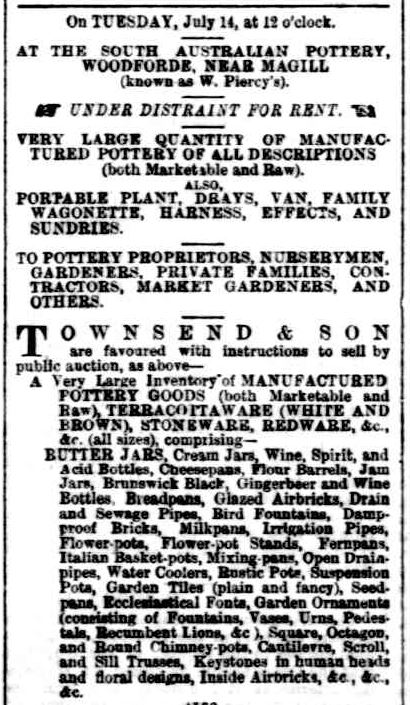
(South Australian Register, 1885, p. 8)
In difficult circumstances, Frederick Piercy managed to continue trading for a few more years, in partnership with John Henry Thomas Trewenack, as Trewenack, Piercy & Co., until the partnership was dissolved in favour of Mr. Trewenack in 1889. (Adelaide Observer, 1889, p. 22) After that time, Frederick Piercy worked for Trewenack's Pottery, Sandford Street, Kensington Gardens, as a manufacturer of 'earthenware'. (Ioannou, 1986, p. 80)
The original lease on the pottery near the corner of Norton Summit and Magill Roads, Magill, included the right to purchase the property after July 1885. In February 1887, following the death of the owner, Mr. Giles, Frederick Piercy at first requested a reduction in the rent, finally purchasing the property in 1888. However, poor sales meant that he had to mortgage the property almost immediately, and the severe economic depression of the 1890s forced Frederick Piercy to put the property up for sale in 1892. (Ioannou, 1986, p. 80)
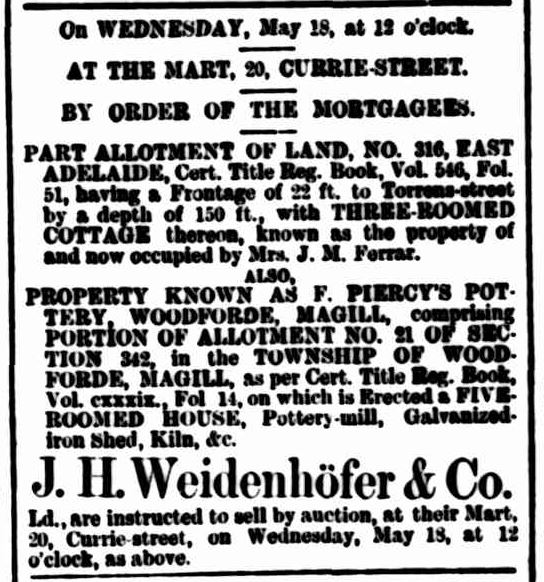
(South Australian Register, 1892, p. 8)
Frederick Piercy relocated Guildford, Western Australia, now a suburb of Perth, in 1894, where he operated a pottery with Robert Hardy. He then joined James Turton at the Woodbridge Brick and Pottery Co., where he worked for 17 years, until the clay was worked out. Finally, helping to establish H. L. Brisbane & Co. Ltd. in Guildford. (The West Australian, 1931, p. 5) Frederick Piercy died in November 1934. (The West Australian, 1934, p. 21)
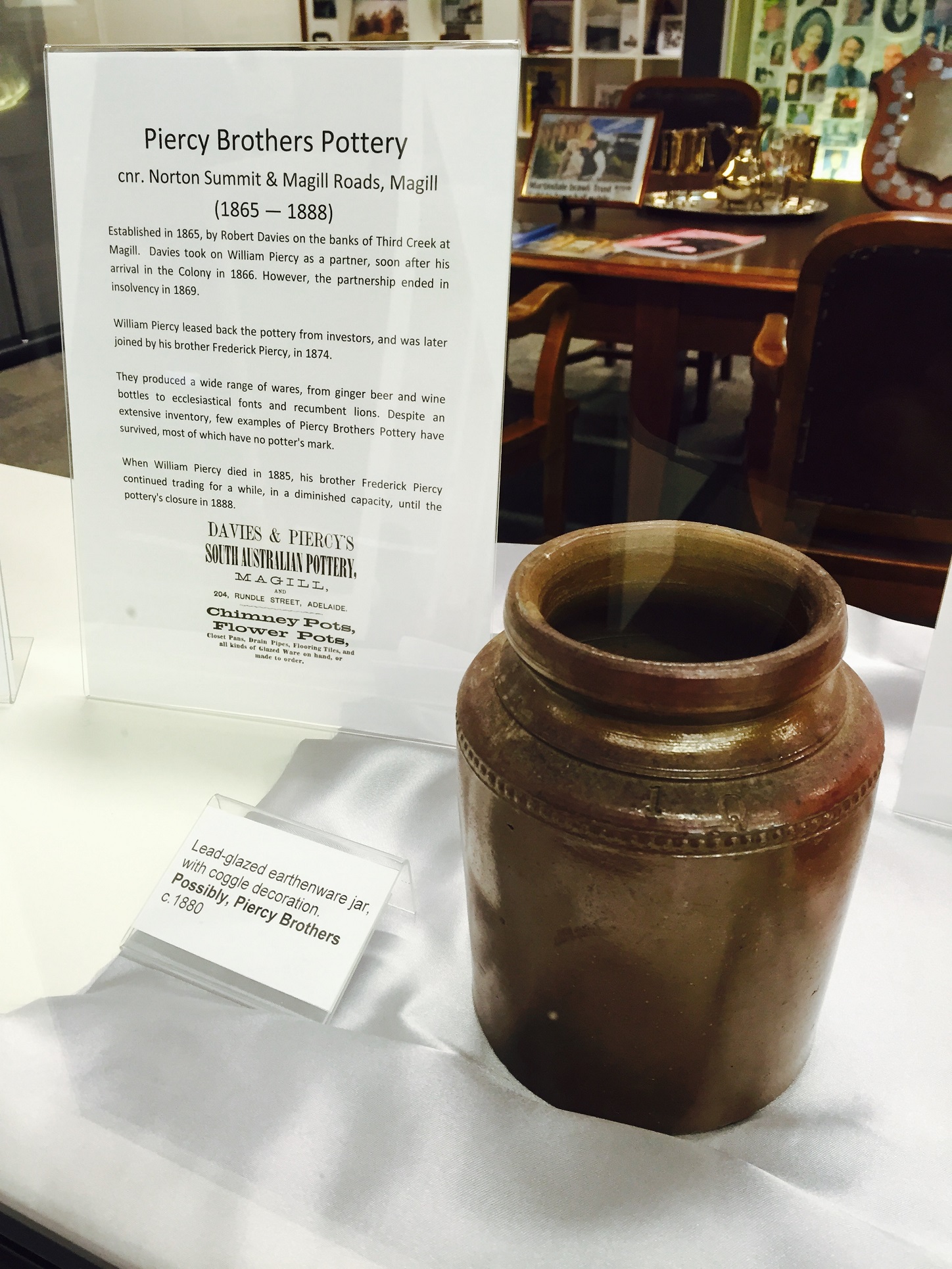
Lead glazed earthenware jar, with coggle decoration.Possibly Piercy Brothers c. 1880.
On display in Campbelltown Library Local History Room, August 2016.
Despite an extensive inventory of wares by The South Australian Pottery, listed during the sale of the Magill pottery works in 1885, ranging from ginger beer bottles to recumbent lions, very few examples of their work appear to have survived, and even fewer works carry a potter's mark. (Ford, 1985, p. 29) The South Australian Pottery, Magill, remains something of an enigma, except for the pervasive influence on the Australian pottery industry by its founders, Robert Davies, William Piercy, and Frederick Piercy.
Researched and written by Helen Thiselton (Local History Officer).
Works Cited
Adelaide Observer. (1889, August 17). Retrieved from Trove: http://nla.gov.au/nla.news-article159535346
Boothby, J. (1869). Adelaide almanack town and country directory and guide to South Australia for 1869. Adelaide: E. S. Wigg and J. Howell.
Chronicle. (1903, March 7). Retrieved from Trove: http://nla.gov.au/nla.news-article87835209
Evening Journal. (1869, November 6). Retrieved from Trove: http://nla.gov.au/nla.news-article197652041
Evening Journal. (1874, May 5). Retrieved from Trove: http://nla.gov.au/nla.news-article196749072
Evening Journal. (1877, January 25). Retrieved from Trove: http://nla.gov.au/nla.news-article197697458
Evening Journal. (1906, July 9). Retrieved from Trove: http://nla.gov.au/nla.news-article201878875
Express and Telegraph. (1877, July 11). Retrieved from Trove: http://nla.gov.au/nla.news-article207574515
Ford, G. (1985). 19th Century South Australian pottery: guide for historians & collectors. Unley (S. Aust.): The Salt Glaze Press.
Ioannou, N. (1986). Ceramics in South Australia 1836-1986: from folk to studio pottery. Netley (S. Aust.): Wakefield Press.
Kapunda Herald. (1903, March 27). Retrieved from Trove: http://nla.gov.au/nla.news-article110275377
Port Pirie Recorder and North Western Mail. (1916, June 28). Retrieved from Trove: http://nla.gov.au/nla.news-article102547985
South Australian Chronicle and Weekly Mail. (1868, December 19). Retrieved from Trove: http://nla.gov.au/nla.news-article90947657
South Australian History Timeline. (n.d.). Retrieved from Family History South Australia: http://www.familyhistorysa.info/timeline.html
South Australian Register. (1864, April 8). Retrieved from Trove: http://nla.gov.au/nla.news-article39122983
South Australian Register. (1866, March 14). Retrieved from Trove: http://nla.gov.au/nla.news-article41018288
South Australian Register. (1870, May 27). Retrieved from Trove: http://nla.gov.au/nla.news-article39206461
South Australian Register. (1885, July 9). Retrieved from Trove: http://nla.gov.au/nla.news-article44942992
South Australian Register. (1892, May 7). Retrieved from Trove: http://nla.gov.au/nla.news-article48232096
The Advertiser. (1903, March 14). Retrieved from Trove: http://nla.gov.au/nla.news-article4931159
The Express and Telegraph. (1868, June 2). Retrieved from Trove: http://nla.gov.au/nla.news-article207738710
The Express and Telegraph. (1869, November 8). Retrieved from Trove: http://nla.gov.au/nla.news-article207684574
The Express and Telegraph. (1885, May 26). Retrieved from Trove: http://nla.gov.au/nla.news-article208348314
The West Australian. (1931, October 6). Retrieved from Trove: http://nla.gov.au/nla.news-article32351306
The West Australian. (1934, November 17). Retrieved from Trove: http://nla.gov.au/nla.news-article32799095
